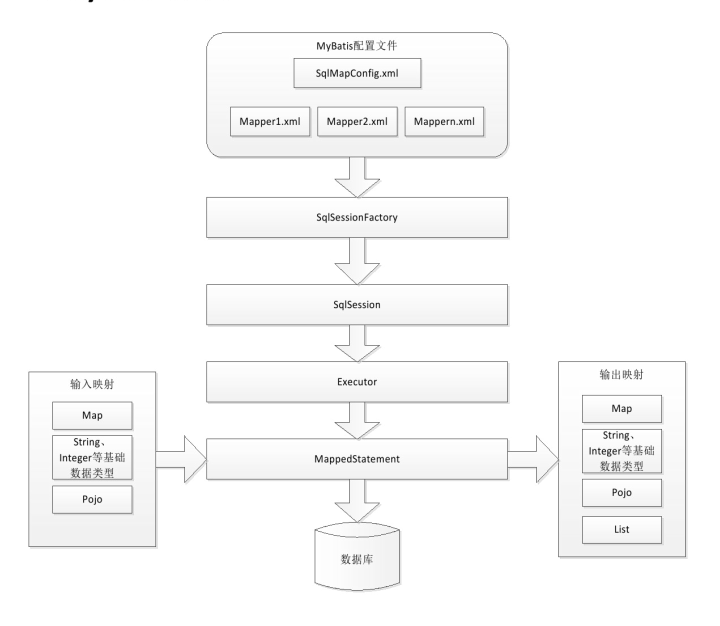一、介绍
Mybatis就是类似于Hibernate的ORM(对象关系映射:把对象模型表示的对象映射到基于SQL的关系模型数据库结构中,在具体的操作实体对象的时候,就不需要再去和复杂的SQL语句打交道,只需简单的操作实体对象的属性和方法)持久层框架。Mybatis封装了jdbc访问数据库的过程,开发时只需专注于SQL语句本身的拼装,其它复杂的过程全部可以交给Mybatis去完成。
二、Jdbc访问数据库的过程:
public static void main(String[] args) {
Connection connection = null;
PreparedStatement preparedStatement = null;
ResultSet resultSet = null;
try {
//加载数据库驱动
Class.forName("com.mysql.jdbc.Driver");
//根据驱动管理类获取连接
connection =
DriverManager.getConnection("jdbc:mysql://localhost:3306/mybatis?characterEncoding=utf-8","root","root");
//定义sql语句 ?表示占位符
String sql = "select * from user where username = ?";
//获取预处理 statement
preparedStatement = connection.prepareStatement(sql);
//设置参数,第一个参数为sql语句中参数的序号(从1开始),第二个参数为设置的参数值
preparedStatement. setString(1, "王五");
//向数据库发出sql执行查询,查询出结果集
resultSet = preparedStatement.executeQuery();
//遍历查询结果集
while (resultSet.next()) {
System.out.println(resultSet. getString("id") +" "+resultSet.getString( "username"));
}
} catch (Exception e) {
e.printStackTrace();
}
finally {
//释放资源
if (resultSet != nu1l) {
try {
resultSet.close();
} catch (SQLException e) {
e. printStackTrace();
}
}
if (preparedStatement != null) {
try {
preparedStatement . close();
}catch (SQLException e){
e. printStackTrace();
}
}
if (connection != null){
try {
connection.close();
}catch (SQLException e) {
e.printStackTrace();
}
}
}
}
三、Jdbc存在的问题:
1、数据库连接创建、释放频繁造成系统资源浪费,从而影响系统性能。如果使用数据库连接池可解决此问题。
解决:sqlMapConfig.xml中配置连接池,使用连接池管理数据库连接。
2、Sql语句在代码中硬编码,造成代码不易维护,实际应用中sql变化的可能较大,sql 变动需要改变java代码。
解决:将sql配置在XXmapper.xml中,实现sql与java代码分离。
3、使用preparedStatement向占有位符号传参数存在硬编码,因为sql语句的where条件不一定,占位符需要一一对应。
解决:mybatis自动将java对象映射到sql语句,通过statement的parameterType定义输入类型。
4、对结果集解析存在硬编码( 查询列名),sql 变化导致解析代码变化,系统不易维护,如能将数据库记录封装成pojo对象解析较方便。
解决:mybatis自动将jsql执行结果映射到java对象,通过statement的resultType定义输出结果类型。
四、Mybatis架构

五、mybatis与hibernate的区别
Mybatis和hibernate不同,它不完全是一个ORM框架,因为MyBatis需要程序员自已编写Sql语句。mybatis可以通过XML或注解方式灵活配置要运行的sql语句,并将java对象和sql语句映射生成最终执行的sql,最后将sql执行的结果再映射生成java 对象。
Mybatis学习门槛低,简单易学,程序员直接编写原生态sql,可严格控制sql执行性能,灵活度高,非常适合对关系数据模型要求不高的软件开发,例如互联网软件、企业运营类软件等,因为这类软件需求变化频繁,一但需求变化要求成果输出迅速。但是灵活的前提是mybatis无法做到数据库无关性,如果需要实现支持多种数据库的软件则需要自定义多套sql映射文件,工作量大。
Hibernate对象/关系映射能力强,数据库无关性好,对于关系模型要求高的软件(例如需求固定的定制化软件)如果用hibernate开发可以节省很多代码,提高效率。但是Hibernate的学习门槛高,要精通门槛更高,而且怎么设计O/R映射,在性能和对象模型之间如何权衡,以及怎样用好Hibernate需要具有很强的经验和能力才行。
总之,按照用户的需求在有限的资源环境下只要能做出维护性、扩展性良好的软件架构都是好架构,所以框架只有适合才是最好。
六、使用Mybatis开发DAO
1、传统Dao开发方式
大致步骤:
1、pojo----->user.java
2、Dao--->UserDao.java(接口)
3、mapper.xml--->user.xml
<mapper namespace="test">
<!-- id:statementId
resultType:查询结果集的数据类型
parameterType:查询的入参
-->
<select id="getUserById" parameterType="int" resultType="com.baidu.mybatis.pojo.User" >
SELECT * FROM USER WHERE id = #{id1}
</select>
<select id="getUserByName" parameterType="string" resultType="com.baidu.mybatis.pojo.User" >
SELECT * FROM USER WHERE username LIKE #{username } // '%${value}%'
</select>
</mapper>
#{} 表示一个占位符号,通过#{}可实现preparedStatement向占位符中设置值,自动进行java类型和jdbc类型转换。#{}可有效防止sql注入。#{}可接收简单类型值或pojo属性值。如果parameterType传输单个简单类型值,#{}括号中可以是value或其它名称。
${} 表示拼接sql串,通过${}可以将parameterType传入的内容拼接在sql中且不进行jdbc类型转换,${}可以接收简单类型值或pojo属性值,如果parameterType传输单个简单类型值,${}括号中只能是value。
4、SqlMapConfig.xml
<configuration>
<mappers>
<mapper resource="sqlMap/user.xml"/>
</mappers>
</configuration>
5、DaoImpl--->UserDaoImpl.java
@Test
public void testGetUserByid() throws IOException {
// 创建SqlSessionFactoryBuilder对象
SqlSessionFactoryBuilder sfb = new SqlSessionFactoryBuilder();
// 查找配置文件创建输入流
InputStream inputStream = Resources.getResourceAsStream("SqlMapConfig.xml");
// 加载配置文件,创建SqlSessionFactory对象
SqlSessionFactory sqlSessionFactory = sfb.build(inputStream);
// 创建SqlSession对象
SqlSession sqlSession = sqlSessionFactory.openSession();
// 执行查询,参数一:要查询的statementId ,参数二:sql语句入参
User user = sqlSession.selectOne("user.getUserById", 1);
List<User> list= sqlSession.selectList("user.getUserByName","%王%"); //#{username }
List<User> list= sqlSession.selectList("user.getUserByName","王");//%${username }%
// 输出查询结果
System.out.println(user);
// 释放资源
sqlSession.close();
}
2、动态代理开发Dao
Mapper接口开发方法只需要程序员编写Mapper接口(相当于Dao接口),由Mybatis框架根据接口定义创建接口的动态代理对象,代理对象的方法体同上边Dao接口实现类方法。
Mapper接口开发需要遵循以下规范:
1、Mapper.xml 文件中的namespace与mapper接口的类路径相同。
2、Mapper接口方法名和Mapper.xml中定义的每个statement的id相同
3、Mapper接口方法的输入参数类型和mapper.xml中定义的每个sql的arameterType的类型相同
4、Mapper 接口方法的输出参数类型和mapper.xml 中定义的每个sql 的 resultType的类型相同
大致步骤:
1、pojo----->user.java
2、Mapper.java(接口文件)-->UserMapper.java
public interface UserMapper{
user getUserById(int id);
}
3、mapper.xml--->UserMapper.xml
<mapper namespace="com.baidu.mapper.UserMapper">
<select id="getUserById" parameterType="int" resultType="com.baidu.mybatis.pojo.user" >
SELECT * FROM USER WHERE id = #{id1}
</select>
</mapper>
4、SqlMapConfig.xml
<configuration>
<mappers>
<mapper resource="mapper/UserMapper.xml"/>
<!--包扫描,需要mapper,xml与mapper接口名称相同-->
<mapper package="com.baidu.mapperl"/>
</mappers>
</configuration>
测试
public void testGetUserByid() throws IOException {
// 创建SqlSessionFactoryBuilder对象
SqlSessionFactoryBuilder sfb = new SqlSessionFactoryBuilder();
// 查找配置文件创建输入流
InputStream inputStream = Resources.getResourceAsStream("SqlMapConfig.xml");
// 加载配置文件,创建SqlSessionFactory对象
SqlSessionFactory sqlSessionFactory = sfb.build(inputStream);
// 创建SqlSession对象
SqlSession sqlSession = sqlSessionFactory.openSession();
//从sqlSession中获取Mapper接口的代理对象
UserMapper userMapper = sqlSession.getMapper(UserMapper.class);
//执行查询方法
User user = userMapper.queryUserById(1);
System.out.println(user);
//和spring整合后由spring管理
sqlSession. close();}
}
七、类型别名typeAliases
在sqlMapConfig中配置
<typeAliases>
<!--单个别名定义 -->
<typeAlias alias="user" type="com.baidu.pojo.user"/>
<!--批量别名定义,扫描整个包下的类,别名为类名(大小写不敏感) -->
<package name="com.baidu.pojo"/>
<package name="其他包"/>
</typeAliases>
mapper.xml中
<select id="getUserById" parameterType="int" resultType="uSeR" >//大小写不敏感
SELECT * FROM USER WHERE id = #{id}
</select>
八、resultMap
resultType可以指定将查询结果映射为pojo,但需要pojo的属性名和sql查询的列名一致方可映射成功。
如果sql查询字段名和pojo的属性名不一致,可以通过resultMap将字段名和属性名作一个对应关系,resultMap 实质上还需要将查询结果映射到pojo 对象中。
resultMap可以实现将查询结果映射为复杂类型的pojo,比如在查询结果映射对象中包括pojo和list实现一对一查询和一对多查询。
<mapper namespace= "com.baidu.mapper.OrderMapper">
<!--resultMap最终还是要将结果映射到pojo上,type就是指定映射到哪个pojo -->
<!-- id: 设置ResultMap的id -->
<resultMap type="order" id="orderResultMap">
<!--定义主键,非常重要。如果是多个字段,则定义多个id -->
<!-- property: 主键在pojo中的属性名-->
<!-- column: 主键在数据库中的列名-->
<id property="id" column="id">
<!--定义普通属性-->
<result property="userId" column= "user_id"/>
<result property= "number" column= "number"/>
<result property= "createt ime" column= "createtime"/>
<result property ="note" columne "note"/>
<!-- 查询所有订单数据 -->
<select id= "query0rderALl" resultMap= "orderResultMap" >
SELECT id, user_ id,number,
createtime, note FROM 'order'
</select>
</mapper>
九、动态sql
1、<if></if>
<select id= "getIdByWhere parameterType="user" resultType="user" >
SELECT id FROM 'user'
where 1=1
<if test="sex!=null and sex!=" "">
And sex=#{sex}
</if>
<if test="username!=null and username!=" "">
And username=#{username}
</if>
</select>
2、<where></where>
<select id= "getIdByWhere parameterType="user" resultType="id" >
SELECT id FROM 'user'
<where>
<if test="sex!=null and sex!=" "">
And sex=#{sex}
</if>
<if test="username!=null and username!=" "">
And username=#{username}
</if>
</where >
</select>
3、<sql></sql>
<select id= "getUserByWhere parameterType="user" resultType="user" >
SELECT <include refid="userFields"/> FROM 'user'
<where>
<if test="sex!=null and sex!=" "">
And sex=#{sex}
</if>
<if test="username!=null and username!=" "">
And username=#{username}
</if>
</where >
</select>
<sql id="userFields">
id,username,sex
</sql>
4、<foreace></foreach>
<select id= "queryUserByIds" parameterType= "queryVo" resultType= "user">
SELECT * FROM、user
<where>
<!-- foreach标签,进行遍历-->
<!-- collection: 遍历的集合,这里是QueryVo的ids属性-->
<!-- item: 遍历的项目,可以随便写,,但是和后面的#{}里面要一致-->
<!-- open: 在前面添加的sql片段-->
<!-- close: 在结尾处添加的sq1片段-->
<!-- separator:指定遍历的元素之间使用的分隔符-->
<foreach collection= "ids" item= "item" open="id IN (" close=")"
separator=",">
#{item}
</foreach>
</where>
</select>
十、关联查询
十一、Mybatis逆向工程
十二、Mybatis整合Spring
整合思路
1、SqISessionFactory 对象应该放到spring容器中作为单例存在。
2、传统dao的开发方式中,应该从spring容器中获得sqlsession对象。
3、Mapper 代理形式中,应该从spring容器中直接获得mapper的代理对象。
4、数据库的连接以及数据库连接池事务管理都交给spring容器来完成。